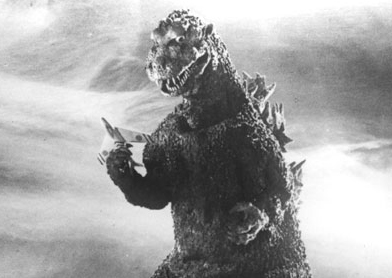So a few weeks ago I got a phone call from a friend and associate, who had an... interesting... offer for me. I got asked if I'd be willing to be hired for a filmmaking job. Guess you could say it would have been my first real gig as a professional: heh-heh, going from no experience to amateur filmmaker to seasoned pro in the space of a few months. Well, there's
plenty about this that I still don't know, and I'm looking for any chance to further my knowledge and understanding of this field. Then my friend went on to talk about the equipment we would be using: the cameras would be
much nicer than anything we used on
Forcery. Top-of-the-line units, the three CCD chips variety (that's the route we'll go on our next movie) we're talking here. Top-notch gear all around. A strong cast of trained and experienced actors. Was I in?
"Heck yeah!" I said.
There was just one catch, my friend told me: it was going to be an unusual filming environment.
Namely, we would be working inside...
A NUCLEAR POWER PLANT!!

Yah that's probably what enters most folks' minds nowadays at the mention of "nuclear power plant". But THIS is what nuclear scary was all about before Homer hit the scene...

1979's
The China Syndrome, the debut of which coming just weeks before Three Mile Island probably didn't hurt it much at the box office. That's
not what first entered my mind when I was told where we'd be doing this at, though. Instead, this was...
 Silkwood
Silkwood. Positively one of the most frightening movies you'll ever see, because this was
a true story folks. Yeah, when someone starts talking about movies and nuclear power, this one always is first to enter my mind. Google has
a lot more about Karen Silkwood if you're interested.
Couldn't talk about this kind of subject without giving this guy at least a passing mention either, eh?

Awright, where were we? Oh yeah... told my friend I'd definitely do it. So I headed out of town for several days this past week to film at the nuclear facility.
Now, I can't say which nuclear plant we were at: "Wally" (not his real name), the plant's liaison to our filming crew, asked me not to publish the name of this facility. I don't want to say where it was either, 'cuz there's not that many nuclear power plants in any given area, right? Nor does the nature of our filming lend itself toward talking much about that. But I can show some photos I took inside the place, along with some information that wouldn't necessarily identify it.
In lieu of being able to show any photos of the plant's exterior, I'll use this:

It looks a lot like Springfield Nuclear Power from
The Simpsons, believe it or not. With the exception of more cooling towers (and they are nowhere as high as the ones at C. Montgomery Burns' establishment). Otherwise the one we were at has two reactors, and sits on a readily-available source of water. The plant we were at is a
pressurized water nuclear reactor plant: the reactor heats up water but instead of turning into steam, high pressure keeps it liquid and has it flowing past another conduit containing water, turning
that into the steam that runs the turbines attached to the generators. What this
really means is that there are two separate water lines: one running through the reactor, and one coming into contact with the outside environment. No excess radiation gets out, unlike a
boiling water reactor that uses steam made in the reactor to power the generators (and in case anyone's interested,
Chernobyl was an entirely different reactor altogether). I asked "Wally" if this plant used heavy water and he said it doesn't: it's a "light water" reactor, and I found out later that's because it's using enriched uranium and plutonium for its fuel. And there is one other
very cool bit of information about this nuclear plant and I'd
love to share what that is on this blog... but I
can't! This nuclear plant is the only one in America that's doing this particular something and that would make identifying it all too easy. Suffice it to say, it's something that absolutely stunned me when he told me about it.
We filmed for a few days and on the last one I whipped out my camera and took these pictures...



Our director took this photo of me...

Here's another shot of me, next to a "CAUTION - HIGH RADIATION AREA" sign...

"Hey look at me, I'm getting an accidental overdose of gamma radiation that's altering my body chemistry!"
Ignore the "Bartlett Nuclear/Bruce Long" on the helmet, 'cuz that wasn't the plant we were at. I've no idea where Bartlett Nuclear might be. And my name ain't Bruce since last time I checked :-)
Okay, something that needs to be said before going any further: we were not, at any time, exposed to high doses of radiation. We were told by "Wally" that nobody goes anywhere near the actual nuclear reactors unless there's a DARNED good reason for doing so. Normally that would be something like loading new fuel rods into the reactor. Otherwise, it's keep way, WAY away from it (especially if you're a newly pregnant woman). Forget what you've seen on The Simpsons: the Springfield Nuclear Plant would have been shut down in a heartbeat if it existed in real life. There are literally safety protocols on top of safety protocols at the plant we were working in: every system has a backup, and there's redundant backups for those backups. Not to mention that this was an incredibly dedicated staff on site: for every hour they spent working there, they spent just as much if not more in training and study, mostly regarding safety. Even if you're fresh out of the U.S. Navy from working with reactors onboard submarines, you're looking at two years of training before you're turned loose on civilian equipment. Anyone think Homer could do something like that? :-) Anyhoo, if there ever was any worries about something... bad... going down at a nuclear plant, what we saw at this facility would easily allay those fears, so don't fret about a Chernobyl happening here.
So where were these photos taken? Inside what is called the Flow Loop simulator. Training directly around the actual reactor isn't the hottest of ideas but something is still needed for hands-on experience. The Flow Loop simulator replicates just about every kind of environment that could be expected in and around the reactors and generators. That's where we were at during part of our filming. We got to see for ourselves: there was only normal background radiation where we were set up at, nothing abnormally high or even slightly high at all. Still, I couldn't resist having some fun in the place while we were there 'cuz hey, it's not every day you get to be turned loose inside a nuclear power plant!

...Better shot at the "workers" inside the simulator. Those are really dummies posed around a mock hazardous material spill.

...Big tank of glycol: wonderful coolant but hideously expensive. They have the actual stuff ready to train with here though.

...Big, BIG replica of a diesel engine. The actual diesels are located further inside the plant, at the generators. If anything were to happen that incapacitated the reactors from running the turbines, these babies can kick in and keep the juice flowing.
'Course, since the thought of a guy like me running around in a place like that is too frightening to contemplate, I had to take a picture guaranteed to scare most sane people...

And, that pretty much sums up where we were at last week when we did this filming. I left knowing
much more about filmmaking than I did prior to this, and learned an awful lot about the nuclear power industry. And got some really neat material for my blog, all in one shot!





















1 comments:
Forgot to mention how much of this place is dedicated to just cooling the thing. I'd say that of the entire works (reactors, generators, ducts, etc.) that more than 2/3rds of the facility is concerned with either transferring the heat from the reactor, or cooling it all down after it heats up the steam at the turbines. The actual reactors are a very tiny part of the whole scheme.
Hey William, some of the newer generation of nuclear reactors are designed to automatically shut down the reaction if excessive heat causes the metal inside the reactor to expand past a certain point. I found that out after getting back from this place. This has gotta be the most self-scrutinizing industry I've ever seen.
Post a Comment